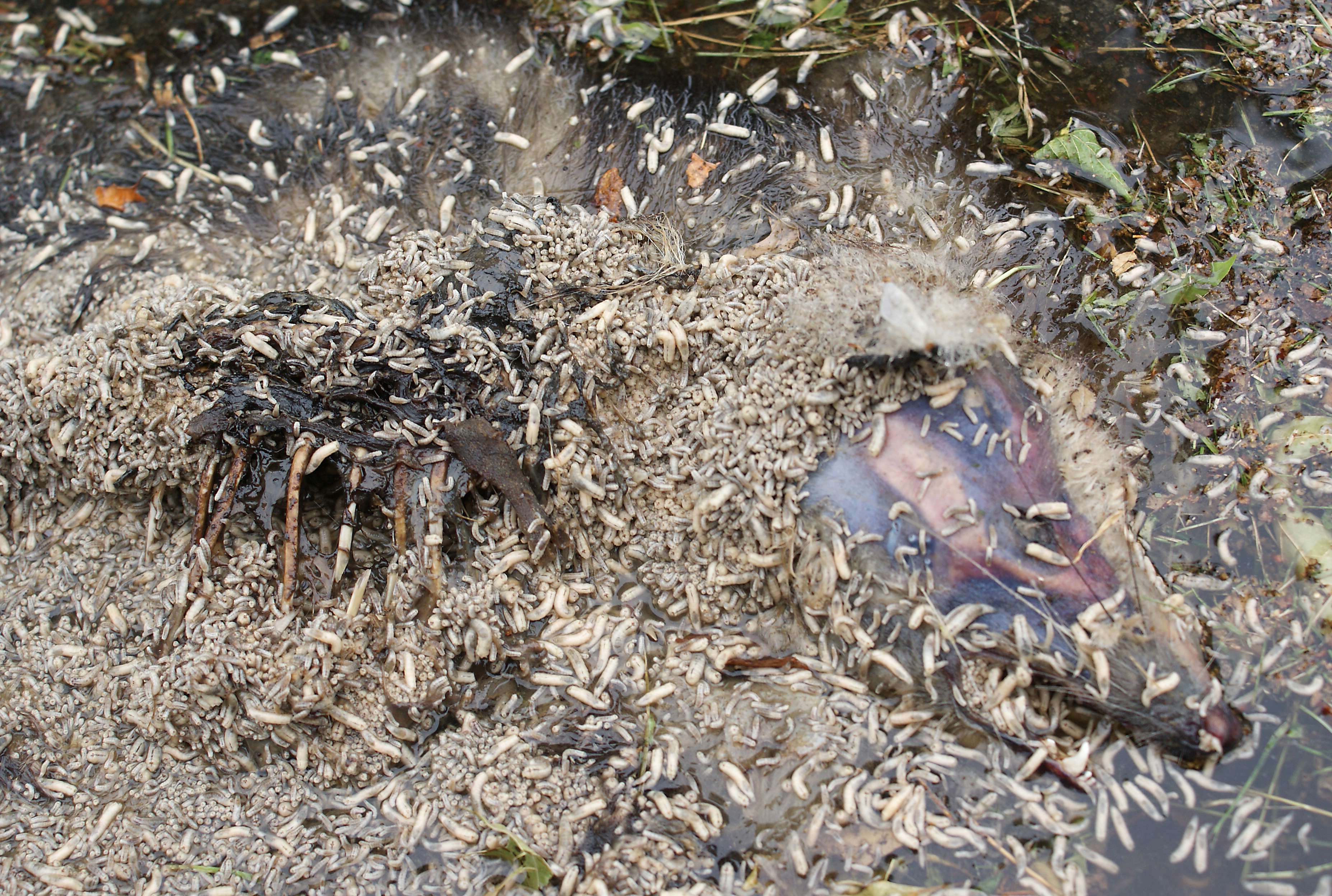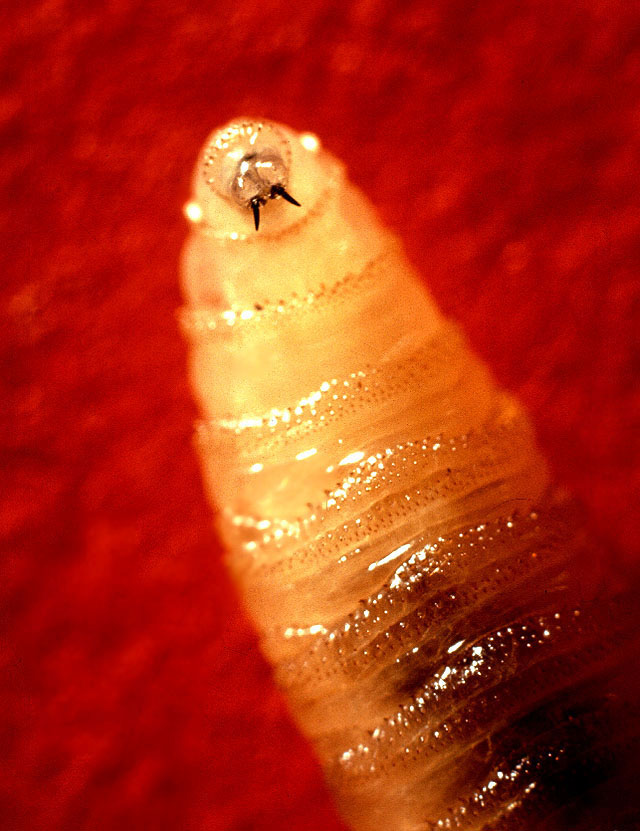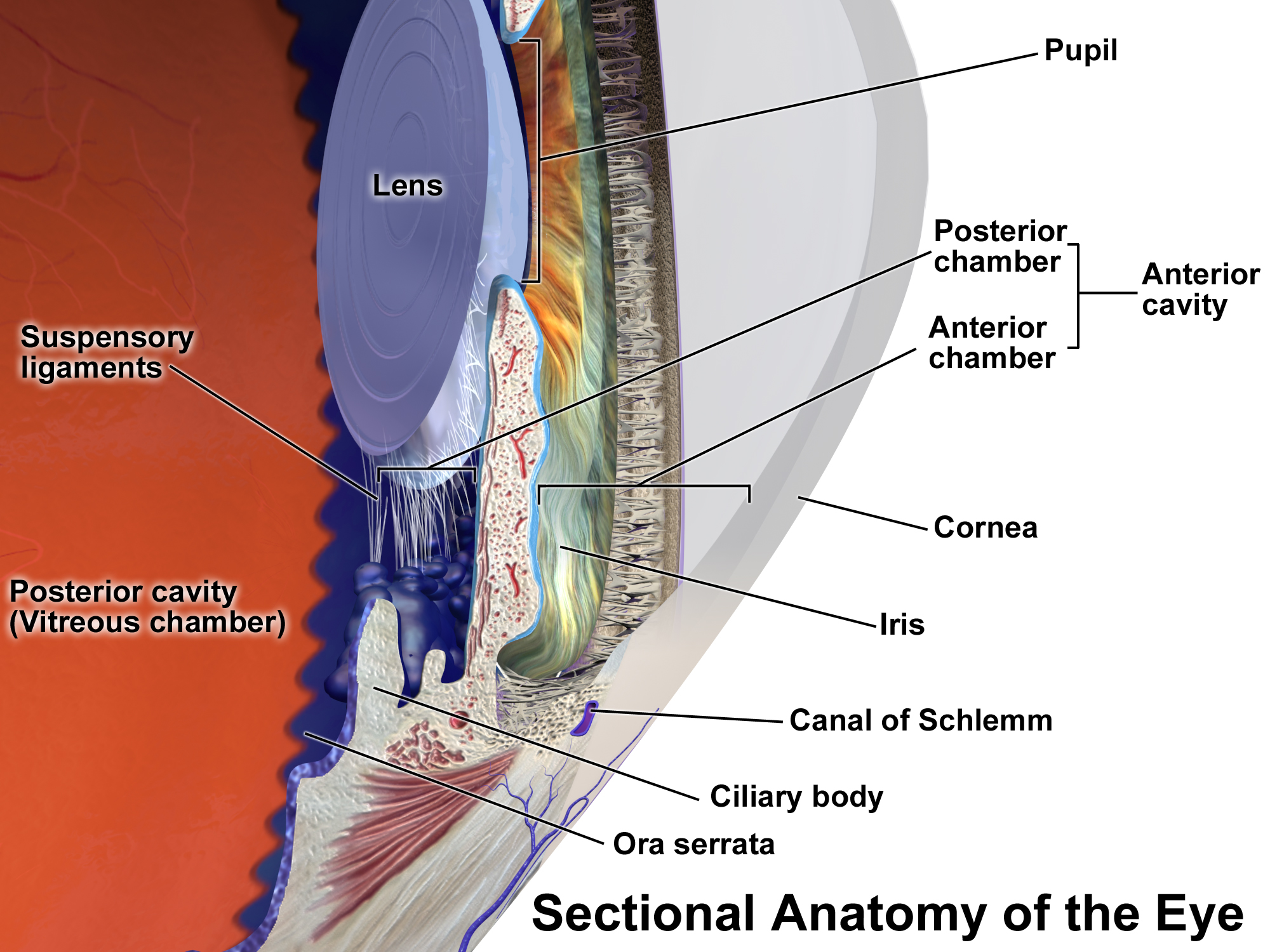|
Myiasis
Myiasis ( ), also known as flystrike or fly strike, is the parasitic infestation of the body of a live animal by fly larvae (maggots) that grow inside the host while feeding on its Biological tissue, tissue. Although flies are most commonly attracted to open wounds and urine- or feces-soaked fur, some species (including the most common myiatic flies—the botfly, Calliphoridae, blowfly, and Cochliomyia hominivorax, screwfly) can create an infestation even on unbroken skin. Non-myiatic flies (such as the common housefly) can be responsible for accidental myiasis. Because some animals (particularly non-native domestic animals) cannot react as effectively as humans to the causes and effects of myiasis, Parasitic flies of domestic animals, such infestations present a severe and continuing problem for livestock industries worldwide, causing severe economic losses where they are not mitigated by human action. Although typically a far greater issue for animals, myiasis is also a relativ ... [...More Info...] [...Related Items...] OR: [Wikipedia] [Google] [Baidu] |
Botfly
Botflies, also known as warble flies, heel flies, and gadflies, are flies of the family Oestridae. Their larvae are internal parasites of mammals, some species growing in the host's flesh and others within the gut. '' Dermatobia hominis'' is the only species of botfly known to parasitize humans routinely, though other species of flies cause myiasis in humans. General A botfly, also written bot fly, bott fly or bot-fly in various combinations, is any fly in the family Oestridae. Their life cycles vary greatly according to species, but the larvae of all species are internal parasites of mammals. Largely according to species, they also are known variously as warble flies, heel flies, and gadflies. The larvae of some species grow in the flesh of their hosts, while others grow within the hosts' alimentary tracts. The word "bot" in this sense means a maggot. A warble is a skin lump or callus such as might be caused by an ill-fitting harness, or by the presence of a warble fly m ... [...More Info...] [...Related Items...] OR: [Wikipedia] [Google] [Baidu] |
Maggot
A maggot is the larva of a fly (order Diptera); it is applied in particular to the larvae of Brachycera flies, such as houseflies, cheese flies, hoverflies, and blowflies, rather than larvae of the Nematocera, such as mosquitoes and crane flies. Etymology "Maggot" is not a technical term and should not be taken as such; in many standard textbooks of entomology, it does not appear in the index at all. In many non-technical texts, the term is used for insect larvae in general. Other sources have coined their own definitions; for example: "The term applies to a grub when all trace of limbs has disappeared" and "Applied to the footless larvae of Diptera".Smith, John. BExplanation of terms used in entomology Brooklyn Entomological Society, 1906. Additionally, in ''Flies: The Natural History and Diversity of Diptera'', the author claims maggots "are larvae of higher Brachycera (Cyclorrhapha)." Maggot-like fly larvae are of significance in ecology and medicine; among other r ... [...More Info...] [...Related Items...] OR: [Wikipedia] [Google] [Baidu] |
Parasitic Flies Of Domestic Animals
Many species of flies of the two-winged type, Order Diptera, such as mosquitoes, horse-flies, blow-flies and warble-flies, cause direct parasitic disease to domestic animals, and transmit organisms that cause diseases. These infestations and infections cause distress to companion animals, and in livestock industry the financial costs of these diseases are high.Wall, R. (2001) ''Veterinary Ectoparasites: biology, pathology & control''. Oxford: Blackwell Science Ltd, .Taylor, M.A. (2007) ''Veterinary Parasitology''. Oxford: Blackwell Publishing, . These problems occur wherever domestic animals are reared. This article provides an overview of parasitic flies from a veterinary perspective, with emphasis on the disease-causing relationships between these flies and their host animals. The article is organized following the taxonomic hierarchy of these flies in the phylum Arthropoda, order Insecta. Families and genera of dipteran flies are emphasized rather than many individual species. Dis ... [...More Info...] [...Related Items...] OR: [Wikipedia] [Google] [Baidu] |
Eristalis Tenax
''Eristalis tenax'', the common drone fly, is a common, migratory, Cosmopolitan species, cosmopolitan species of hover fly. It is the most widely distributed syrphid species in the world, and is known from all regions except the Antarctic. It has been introduced species, introduced into North America and is widely established. It can be found in gardens and fields in Europe and Australia. It has also been found in the Himalayas. Distribution The larval form of the drone-fly, the rat-tailed maggot, is found on every continent except Antarctica, and ranges to the highest latitudes in the North. This species is not prevalent in extremely southern latitudes, neither is it common in arid areas of Europe, Asia, and Africa. In the United States, this species is found as far north as Alaska and as far south as California and Florida. Description ''Eristalis tenax'' is a large, stocky bee mimic. The eyes are marbled in black. Males have hovering displays. The average wing length is 9.75 ... [...More Info...] [...Related Items...] OR: [Wikipedia] [Google] [Baidu] |
Calliphoridae
The Calliphoridae (commonly known as blowflies, blow flies, blow-flies, carrion flies, bluebottles, or greenbottles) are a family of insects in the order Diptera, with almost 1,900 known species. The maggot larvae, often used as fishing bait, are known as gentles. The family is known to be polyphyletic, but much remains disputed regarding proper treatment of the constituent taxa, some of which are occasionally accorded family status (e.g., Bengaliidae and Helicoboscidae). Description Characteristics Calliphoridae adults are commonly shiny with metallic colouring, often with blue, green, or black thoraces and abdomens. Antennae are three-segmented and aristate. The aristae are plumose their entire length, and the second antennal segment is distinctly grooved. Members of Calliphoridae have branched Rs 2 veins, frontal sutures are present, and calypters are well developed. The characteristics and arrangements of hairlike bristles are used to differentiate among members of ... [...More Info...] [...Related Items...] OR: [Wikipedia] [Google] [Baidu] |
Cochliomyia Hominivorax
''Cochliomyia hominivorax'', the New World screwworm fly, or simply screwworm or screw-worm, is a species of parasitic fly that is well known for the way in which its larvae (maggots) eat the living tissue of warm-blooded animals. It is present in the New World tropics. Of the five species of '' Cochliomyia'', only ''C. hominivorax'' is parasitic; a single parasitic species of Old World screwworm fly is placed in a different genus (''Chrysomya bezziana''). Infestation of a live vertebrate animal by a maggot is technically called myiasis. While the maggots of many fly species eat dead flesh, and may occasionally infest an old and putrid wound, screwworm maggots are unusual because they attack healthy tissue. This increases the chances of infection, and damaged tissue also attracts more of these flies . The New World screwworm fly was the first species upon which the sterile insect technique was tested, and then applied in a natural environment, resulting in the control and sy ... [...More Info...] [...Related Items...] OR: [Wikipedia] [Google] [Baidu] |
Vulvar Myiasis
Myiasis is a parasitic infestation caused by larvae of several fly species. Diagnosis and treatment are generally quite simple. This infestation is, however, rarely seen in the vulva In mammals, the vulva (: vulvas or vulvae) comprises mostly external, visible structures of the female sex organ, genitalia leading into the interior of the female reproductive tract. For humans, it includes the mons pubis, labia majora, lab ...r area. Infestation of vulvar area with larvae and maggots is called vulvar myiasis. Very few cases have been described in literature. References Further reading * says "BACKGROUND: To report a rare case of vulvar myiasis caused by Wohlfahrtia magnifica, including clinical and microscopic observations. CASE: A vulvar lesion was found in a 31-year-old married female villager with the history of dropping fly larvae from vulva, vulvar pain and itching sensation. The larvae were identified as the species of Wohlfartia magnifica. The lesion was washed with ... [...More Info...] [...Related Items...] OR: [Wikipedia] [Google] [Baidu] |
Uveitis
Uveitis () is inflammation of the uvea, the pigmented layer of the eye between the inner retina and the outer fibrous layer composed of the sclera and cornea. The uvea consists of the middle layer of pigmented vascular structures of the eye and includes the iris, ciliary body, and choroid. Uveitis is described anatomically, by the part of the eye affected, as anterior, intermediate or posterior, or panuveitic if all parts are involved. Anterior uveitis ( iridocyclitis) is the most common, with the incidence of uveitis overall affecting approximately 1:4500, most commonly those between the ages of 20–60. Symptoms include eye pain, eye redness, floaters and blurred vision, and ophthalmic examination may show dilated ciliary blood vessels and the presence of cells in the anterior chamber. Uveitis may arise spontaneously, have a genetic component, or be associated with an autoimmune disease or infection. While the eye is a relatively protected environment, its immune mecha ... [...More Info...] [...Related Items...] OR: [Wikipedia] [Google] [Baidu] |
Glaucoma
Glaucoma is a group of eye diseases that can lead to damage of the optic nerve. The optic nerve transmits visual information from the eye to the brain. Glaucoma may cause vision loss if left untreated. It has been called the "silent thief of sight" because the loss of vision usually occurs slowly over a long period of time. A major risk factor for glaucoma is increased pressure within the eye, known as Intraocular pressure, intraocular pressure (IOP). It is associated with old age, a family history of glaucoma, and certain medical conditions or the use of some medications. The word ''glaucoma'' comes from the Ancient Greek word (), meaning 'gleaming, blue-green, gray'. Of the different types of glaucoma, the most common are called open-angle glaucoma and closed-angle glaucoma. Inside the eye, a liquid called Aqueous humour, aqueous humor helps to maintain shape and provides nutrients. The aqueous humor normally drains through the trabecular meshwork. In open-angle glaucoma, ... [...More Info...] [...Related Items...] OR: [Wikipedia] [Google] [Baidu] |
Retinal Detachment
Retinal detachment is a condition where the retina pulls away from the tissue underneath it. It may start in a small area, but without quick treatment, it can spread across the entire retina, leading to serious vision loss and possibly blindness. Retinal detachment is a medical emergency that requires surgery. The retina is a thin layer at the back of the eye that processes visual information and sends it to the brain. When the retina detaches, common symptoms include seeing floaters, flashing lights, a dark shadow in vision, and sudden blurry vision. The most common type of retinal detachment is rhegmatogenous, which occurs when a tear or hole in the retina lets fluid from the center of the eye get behind it, causing the retina to pull away. Rhegmatogenous retinal detachment is most commonly caused by posterior vitreous detachment, a condition where the gel inside the eye breaks down and pulls on the retina. Risk factors include older age, nearsightedness ( myopia), eye injury, ... [...More Info...] [...Related Items...] OR: [Wikipedia] [Google] [Baidu] |
Infectious Disease (medical Specialty)
Infectious diseases (ID), also known as infectiology, is a medical specialty dealing with the diagnosis and treatment of infections. An infectious diseases specialist's practice consists of managing nosocomial (Hospital-acquired infection, healthcare-acquired) infections or community-acquired infections. An ID specialist investigates and determines the cause of a disease (bacteria, virus, parasite, fungus or prions). Once the cause is known, an ID specialist can then run various tests to determine the best drug to treat the disease. While infectious diseases have always been around, the infectious disease specialty did not exist until the late 1900s after scientists and physicians in the 19th century paved the way with research on the sources of infectious disease and the development of vaccines. Scope Infectious diseases specialists typically serve as consultants to other physicians in cases of complex infections, and often manage patients with HIV/AIDS and other forms of immuno ... [...More Info...] [...Related Items...] OR: [Wikipedia] [Google] [Baidu] |
Buttocks
The buttocks (: buttock) are two rounded portions of the exterior anatomy of most mammals, located on the posterior of the pelvic region. In humans, the buttocks are located between the lower back and the perineum. They are composed of a layer of exterior skin and underlying subcutaneous fat superimposed on a left and right gluteus maximus and gluteus medius muscles. The two gluteus maximus muscles are the largest muscles in the human body. They are responsible for movements such as straightening the body into the upright (standing) posture when it is bent at the waist; maintaining the body in the upright posture by keeping the hip joints extended; and propelling the body forward via further leg (hip) extension when walking or running. In many cultures, the buttocks play a role in sexual attraction. Many cultures have also used the buttocks as a primary target for corporal punishment, as the buttocks' layer of subcutaneous fat offers protection against injury while still ... [...More Info...] [...Related Items...] OR: [Wikipedia] [Google] [Baidu] |






